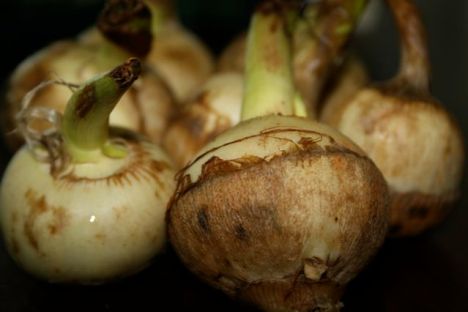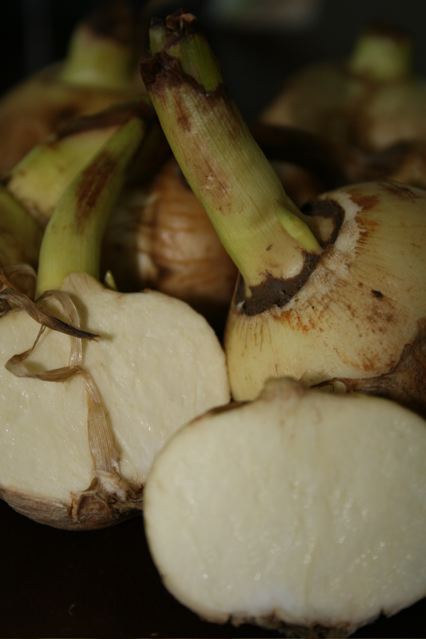Arrowroot a.k.a cí gū, ngah gu, etc, etc ,etc… is an interesting plant that landed me into World of Culinary Confusion lately. It’s also called “arrowhead” due to the shape of its leaves. I had tasted this strangely named plant after I read it in the local newspaper couple of years ago, which made a coverage about the boosting of sales of certain enterprising individuals who sold bottles of homemade fried Arrowroot chips to earn extra cash during the Chinese New Year. Well, I did bought some of this fresh Arrowroots making the chips myself… 😀 Indeed it’s yummmmyyyy… and you just can’t stop chomping and more chompings until it’s gone from your plate. In my case, it’s straight from the wok to newspaper/kitchen paper-lined colander and munch, munch… Hey, it’s better than buying those state-of-the-art branded chips-and-dips packed along with preservatives, colorings and artificial flavourings at the supermarkets. It’s not that I’m a stingy or health fanatic person but just to satisfy my curiosity of this root the made hoo-haas in the local news..:-P
So, when I returned home from abroad during the 15 days long CNY celebration this year, I had the chance to taste this yummy chips again at my youngest sister’s home… she bought it from someone, I think… 🙂 The taste of the chips as I munched away brought back the memories… hehehehe!
Anyway, I started to look for more info about this arrowroot thing because back in EU, I used this little container of left over arrowroot powder as thickener for my cooking. It’s a wonderful thickener agent and has no funny smell or after taste like cornstarch or potato starch powder (reminds me of my mum used to make this gooey, transparent colloid thing to starch my dad’s police uniforms… urghhh! This made me wonder if the uniform can stand stiff by itself without any hangers! 😀 Dad said I read too much of Master Q a.k.a Lao Fu Tze mags! Errhmmmm… now I remembered one of Master Q’s tall friend (not the shortie) whose ironed pants can even cut through wood… hahhahahaa!!!
Ok… let’s get back into this arrowroot case! There’s a bit of confusion not only for me but I think to other foodies as well. There are several blogs or websites that mentioned about this tasty bulbs… So far, the most cultivated are Maranta, Sagittaria and Pueraria genuses (though other subspecies or tubers may produce the same usage starch). The Maranta should not be confused with Sagittaria species (Sagittaria sagittifolia) with round tubers which also called “arrowhead” and used as a root vegetable-that’s the genus they called ‘nga gu’ or ci gu and is eaten particularly during Chinese New Year in stews or make into chips.. 🙂

Tuber/bulb of Arrowroot (Sagittaria sagittifolia) a.k.a cí gū
The broadleaf arrowhead (Sagittaria latifolia also known as duck potato, Indian potato, or wapato) produces edible tubers that were heavily collected by the Native Americans as a food source. Most have value as food for wildlife. Some are grown as ornamental plants in bog gardens, bowls, ponds or aquariums.- aquatic plants whose members go by a variety of common names, including arrowhead, duck potato, katniss, kuwai, swan potato, tule potato, and wapatoo.
Now, if I understood, the arrowroot powder that’s available commercially belongs to the genus Maranta which is chiefly cultivated in the West Indies (Jamaica and St. Vincent), Australia, Southeast Asia, and South and East Africa. Arrowroot is used as an article of diet in the form of biscuits, puddings, jellies, cakes, etc., and also with beef tea, milk or veal broth, noodles in Korean cuisine, or boiled with a little flavoring added, as an easily digestible food for children and people with dietary restrictions. It’s amazing that besides its usage in culinary, it’s also has medicinal potential to papermaking!
But… there’s another type of root a.k.a Arrowroot that has large fan clubs called Kudzu or Kuzu in Japanese, is another basic element in Japanese cuisine. It’s even highly mentioned in their art or literary form, from tea ceremony, painting and calligraphy! Kuzuyaki, one of the traditional wagashi, Japanese summer sweets, is made by steaming a mixture of kuzu (kudzu starch) and sweet bean paste. It is cut into individual portions after coolinng down, coated with potato starch and grilled.
Kuzu is said to be originates from Nara, the roots of Kyoto food. The severe weather conditions of the basin contribute to kuzu making, a necessity for Japanese sweets and dishes. Yoshino kuzu is made in the northern Yoshino Mountains – famous for its cherry blossoms – and Ouda. Both regions are famous for its kuzu production.
Yoshino kuzu is made during the cold winter months from the root of the arrowroot grown deep in the mountain ranges of Yamato. When starch taken from the root is refined by water, you have yoshino-kuzu. At “Kurokawa Honke” in Oudacho, the veteran craftsmen continue to make the finest yoshino-kuzu using the same method without any fire that has been used for over 400 years. “Good water and extremely cold weather determines the quality of kuzu. If the water temperature is too high, it is difficult to separate the tannin and other impurities in the kuzu,” says Kurokawa Shigeyuki, the eleventh master of Kurokawa family. The starch from crushed fibers of the arrowroot plant is refined in cold well water – so cold that your hands feel numb – for 48 hours. The starch is then refined in fresh well water again, after the water with grounds is eliminated. This is called kan-zarashi (cold refinement), and after the procedure is repeated five times over the course of 10 days, the kuzu is then dried by cold wind. Yoshino-kuzu, with its unique flavour, is used as the valued ingredient of yoshino-ni (stew), goma-dofu (sesame tofu) and high-class Japanese sweets. Such an ode to such a humble plant!
You may ask what’s the great deal about this Kuzu??? It claimed that it may help reduce alcohol consumption in heavy drinkers as reported in New Scientist. Overall, the whole plant can be consumed… by humans or as fodder to animals.
In Korea, Arrowroot tea or chik cha-made with the juice pressed from wild arrowroot. Powdered arrowroot can also be used) is used for a weak body and thirst caused by a hangover. It is also effective in treating colds, headaches, diabetes, diarrhea, edema, jaundice, hangovers, high blood pressure, and angina. hmmm…. I have to look out for this tea… during winter! I wonder if it’s the same as Sahlep drink I loved???
Ooofffssss the list is endless with this gift from Mother Nature! Imagine loads of wonderful recipes we can create from this humble plant-from soups to beverages and desserts too! Oh, it’s gluten-free as welL… There are also recipes for wine (hmmm.. reminds me that I have to hunt for Pithaya Wine brewed locally in Malaysia! … and much, much more.
Here’s few links that are worth mentioning…
http://eatingasia.typepad.com/eatingasia/2007/02/duck_potatoes_f.html
http://cookingismypassion.blogspot.com/2007/02/delicious-handfuls-of-golden-chips.html
http://penangfaces.chanlilian.net/2005/01/18/siku-seegoo-homemade-chips/
http://www.chowhound.com/topics/361394
http://www.hungrybrowser.com/phaedrus/m011802.htm#5
Now… my next trip will to the local Japanese mini-mart to look for kuzu powder which I’d seen before…
Filed under: Vegetable | Tagged: arrowroot, ethnic, herb, kudzu, kuzu, Sagittaria, Sagittaria sagittifolia, Vegetable | 2 Comments »



